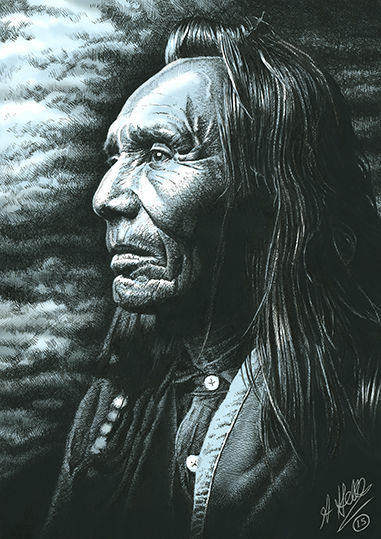
Three Eagles, Nez Perce Tribe Warrior, 1910
The Nez Perce are a tribe of Native Americans who live in the Pacific Northwest region of the United States. The Nez Perce's name for themselves is Nimíipuu, which means simply "the people", or "we the people". The name "Nez Percé", meaning "pierced nose", is derived from the French, a name inspired by nose pendants some of them wore, although this practice was more common among tribes downriver.
In 1800, there were over 70 permanent Nez Perce villages ranging from 30 to 200 individuals, depending on the season and social grouping. About 300 total sites have been identified, including both camps and villages. In 1805 the Nez Perce were the largest tribes on the Columbia River Plateau, with a population of about 6,000.
The Nez Perce were migratory and would travel with the seasons, according to where the most abundant food was to be found at a given time of year. This migration followed a predictable pattern from permanent winter villages through several temporary camps, nearly always returning to the same locations year after year. The people believed in spirits called weyekins which would offer "a link to the invisible world of spiritual power". The weyekin would protect one from harm and become a personal guardian spirit. It would stay with the person until death.
Under pressure from the European Americans, in the late 19th century the Nez Perce split into two groups: one side accepted the coerced relocation to a reservation and the other refused to give up their fertile land in Idaho and Oregon. Those willing to go to a reservation made a treaty in 1877. The flight of those who refused began on June 15, 1877, with Chief Joseph, Looking Glass, White Bird, Ollokot, Lean Elk and Toohoolhoolzote leading 2,900 men, women and children in an attempt to reach a peaceful sanctuary. They intended to seek shelter with their allies, the Crow tribe, but upon the Crow's refusal to offer help, the Nez Perce tried to reach the camp in Canada of Lakota Chief
Sitting Bull. He had migrated there after decisively defeating United States forces in the Battle of the Little Bighorn.
The Nez Perce were pursued by over 2,000 soldiers of the U.S. Army on an epic flight to freedom of more than 1,170 miles across four states and multiple mountain ranges. The 800 Nez Perce warriors defeated or held off the pursuing troops in 18 battles, skirmishes, and engagements. More than 300 US soldiers and 1,000 Nez Perce (including women and children) were killed in these conflicts.
A majority of the surviving Nez Perce were finally forced to surrender on October 5 after the Battle of the Bear Paw Mountains in Montana, just 40 miles from the Canadian border. Chief Joseph
surrendered to General Oliver O. Howard of the U.S. Cavalry. During the surrender negotiations, Chief Joseph sent a message, usually described as a speech, to the US soldiers. It has become renowned as one of the greatest American speeches: "...Hear me, my chiefs, I am tired. My heart is sick and sad. From where the sun now stands, I will fight no more forever."
This image was drawn from a photograph taken by Edward S. Curtis in 1910. I found the photograph to be utterly intriguing and wonder whether Three Eagles took part in these epic battles.